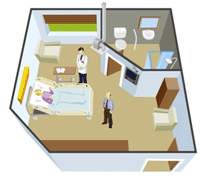WHO estimates indicate:
- Europe: 37,000 deaths directly attributed to HAI annually; plays a role in 110,000 more
- USA: 99,000 attributable deaths annually
- Low-resource countries: preventable HAI-related deaths in ICUs may be 1/4 or more
- Annual economic burden: €7 billion in Europe; $6.5 billion in USA
Definition
Healthcare-associated infections (HAI) are caused bacteria, viruses and fungi. Most of these diseases can be contracted anywhere, but they present greater challenges in the healthcare setting. The majority of HAI are caused by bacteria already present in the patient’s body prior to the infection, and may lead to cross-transmission between patients or between patients and healthcare professionals. The environment in a healthcare facility can also be a source of infection, with microorganism spread through air, water or surfaces. Patients in health facilities are more vulnerable than the general population due to underlying illness, greater fragility (such as for premature babies, the elderly, and immunocompromised patients), and exposure to invasive medical procedures.
HAI is a global challenge
In many high-income countries, national and regional health authorities, along with individual healthcare institutions, are putting into place prevention, control, surveillance and reporting measures. Even if significantly reduced in the recent years, incidence of HAI remains high, particularly among at-risk populations. For example, approximately 25-30% of ICU patients in high-income countries experience at least one HAI episode1,2. In low- and middle- income countries, the challenges are further complicated by underdeveloped infrastructures and issues related to hygiene and sanitation. The WHO estimates that ICU-acquired infection is at least 2-3-fold higher than in high-income countries and that device-associated infection may be up to 13 times higher than in the US1.
HAIs include all types of infections including urinary-tract infections (most common in higher-income countries1,2), surgical site infections (most common in lower-income countries1), respiratory infections, gastro-intestinal infections and bloodstream infections. The emergence of antimicrobial resistant organisms is contributing to an increase in the spread and severity of HAI. A healthcare institution experiencing an outbreak of HAI faces serious patient-care challenges, cost burden, and potential for negative effect on image and reputation.
When is an infection considered to be HAI?
An infection is called a healthcare-associated infection (HAI) when a patient does not present an infection when admitted, but contracts one 48 hours or more after admission to a healthcare facility. For surgical patients, an infection is considered HAI up to three months after surgery, or up to one year in the case of bone or joint surgery3.
Diagnosis
It is critical to regularly carefully monitor all patients in a healthcare facility for infectious diseases, especially those in the ICU or at particular risk for other reasons. In vitro diagnostics are used to accurately determine the infectious agent responsible, and to test for antimicrobial susceptibility, to select appropriate antimicrobial therapy to fight the disease. It is also important to identify and limit potential epidemics by surveying at-risk patient populations and rapidly determining the origin of infections.
Microorganisms commonly involved in HAI1,2,4
- Staphylococcus aureus
- Methicillin resistant Staphylococcus aureus (MRSA)
- Enterococci
- Escherichia coli
- Klebsiella pneumoniae
- Carbapenem-resistant Enterobacteriaceae (CRE)
- Clostridium difficile
- Extended spectrum β-lactamase-producing Enterobacteriaceae (ESBLs)
- Pseudomonas aeruginosa
- Acinetobacter baumannii
- Vancomycin-resistant Enterococcus
- Streptococci
- Candida albicans
Prevention and management / Treatment
Prevention and management
Prevention measures to fight HAI must be implemented at both the patient level and institution-wide.
- Environmental control
- Regular air, water and surface monitoring
- Stringent cleaning and disinfection of equipment and environments
- Patient isolation (or cohorting) when appropriate
- Infection control
- Close monitoring of at-risk patients and populations
- Hand hygiene and good general hygiene practices
- Hygienic conditions for medical procedures
- Appropriate use antimicrobial drugs
- Use of catheters only as indicated
- Surveillance
- Outbreak management
- Automated alerts for antimicrobial-resistant infections
- Information transfer and management
- High-level, coordinated reporting
- Epidemiological surveillance and tracking
- Treatment
- Treatment with appropriate antimicrobials
- Removal of temporary medical devices (such as catheters) if possible
- Therapeutic monitoring to stop antimicrobials as early as possible
Guidelines
- Top CDC Recommendations to Prevent Healthcare‐Associated Infections
- CDC/NHSN 2014: Surveillance Definitions for Specific Types of Infections
- WHO 2011: Core components for infection prevention and control programmes Assessment tools for IPC programmes
- CDC 2003: Guidelines for Environmental Infection Control in Health-Care Facilities
- WHO 2002: Prevention of hospital-acquired infections: A PRACTICAL GUIDE, 2nd edition
References
1. World Health Organization 2011: Report on the Burden of Endemic Health Care-Associated Infection Worldwide
2. CDC, Public Health Reports 2007: Estimating Health Care-Associated Infections and Deaths in U.S. Hospitals, 2002
3. CDC/NHSN 2014: Surveillance Definitions for Specific Types of Infections
4. CDC: Antibiotic Resistance in the United States 2013
This Site is Not a Source of Medical Advice
The Healthcare Content of this Site is presented in summary form, is general in nature, and is provided for informational purposes only. It is not intended nor recommended to be used as a substitute for professional medical advice. You should not use the Healthcare Content of this Site for diagnosing a health or fitness problem or disease. Always seek the advice of your physician or other qualified health provider regarding any medical condition or treatment. Nothing contained on this Site is intended to be for medical diagnosis or treatment. It should not be used by physicians as a single source of information for making prescribing decisions. Never disregard medical advice or delay in seeking it because of something you have read on this Site.


